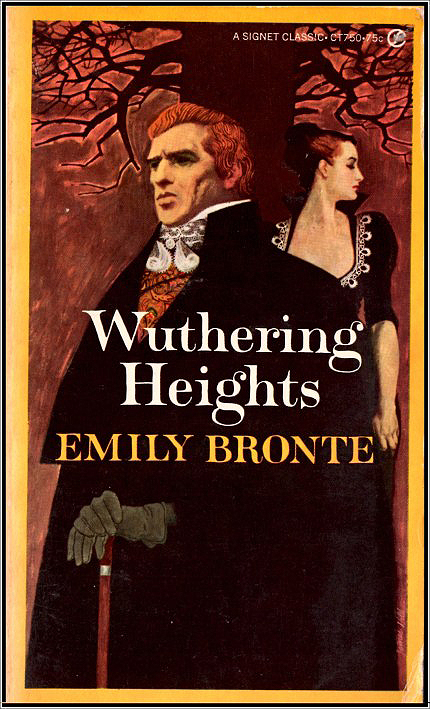Wuthering Heights, Emily Brontë’s singular masterpiece, beckons readers into a tumultuous world drenched in passionate fervor and stark emotional landscapes. Since its publication in 1847, this novel has captivated countless literary enthusiasts, raising essential questions about love, vengeance, and the enduring human spirit. Wuthering Heights possesses an almost magnetic allure, attracting diverse interpretations and resonating with a wide array of reader experiences, making it a perennial subject of analysis.
At first glance, the story unfolds in the somber Yorkshire moors, where Heathcliff—a brooding, tortured soul—navigates the depths of his tumultuous relationship with Catherine Earnshaw. Their intense, yet destructive bond ignites fervent discussions among scholars and readers alike, probing the rationale behind the consuming nature of their love. On the surface, it is a tale punctuated by a visceral blend of romanticism and vengeance that endures through generations. Yet, the deeper psychological undercurrents and societal reflections embedded within the narrative challenge the reader to consider more than just the surface drama.
One of the most captivating aspects of Wuthering Heights lies in its duality of characters, particularly the juxtaposition between Heathcliff and Edgar Linton. While Heathcliff embodies raw emotional intensity, replete with despair and a need for revenge, Edgar represents the genteel, societal expectations of propriety and restraint. Their contrasting natures are not merely fodder for melodrama; they signify broader themes of class struggle and the innate human desire for connection. Readers are left to ponder whether love can indeed triumph over societal boundaries, or if it is consistently thwarted by them.
The motivations behind Heathcliff’s relentless pursuit of vengeance are both tragic and understandable. His early life, marked by abuse and neglect, sows the seeds of his bitterness and rage, compelling many to empathize with him despite his often-monstrous actions. Brontë crafts Heathcliff not only as a romantic anti-hero but as a product of his environment—a reflection of the oppressive societal structures that dehumanize individuals. Consequently, the novel interrogates the nature of morality: Is it justifiable to indulge in revenge if one has been grievously wronged? Such philosophical dilemmas imbue the text with depth, eliciting introspection from the reader about their own perceptions of justice and consequence.
The setting plays a crucial role in reinforcing the novel’s themes. The Yorkshire moors, with their savage beauty and isolation, mirror the tumultuous emotions of the characters. The tumultuous weather patterns and stark landscapes echo the internal conflicts that the protagonists endure, almost as if the elements are participating in the drama. The wildness of the moors symbolizes freedom but also entrapment—a fitting backdrop for a story that oscillates between extreme emotional states. The isolation experienced by Heathcliff and Catherine resonates with readers, who may see reflections of their own struggles within the vast expanse of the landscape.
Catherine’s infamous declaration, “I am Heathcliff,” encapsulates the essence of their bond, suggesting an intrinsic connection that transcends physical existence. This phrase reverberates through the narrative, serving as a haunting reminder of the depths of their emotional entanglement. The problematic nature of their love raises questions about the dichotomy between passion and sanity. Can love be exalted when it entangles individuals in an endless cycle of pain? Brontë deftly navigates this terrain, encouraging a reevaluation of romantic ideals and the costs associated with them.
Despite its dark themes, Wuthering Heights invites a broad spectrum of interpretations, captivating readers with its intricately woven narrative structure and the layering of narration that adds complexity to the storytelling. The use of multiple narrators—most notably, Mr. Lockwood and Nelly Dean—establishes a mosaic of perspectives that challenge the reader’s understanding of truth. Each character brings their own biases, enriching the narrative and underscoring the idea that reality is often contingent upon one’s viewpoint and experiences.
Furthermore, the generational cycles of pain and revenge within the story serve as a pertinent reminder of how the past can irrevocably shape the present. Heathcliff’s wrath manifests not only in his own life but extends to the next generation, weaving a tapestry of retribution that entraps his offspring. This cyclical nature of suffering raises poignant questions about the legacy of trauma and the possibility of redemption. Brontë invites readers to contemplate whether breaking such cycles is attainable or if they are doomed to repeat transgressions across generations.
The profound fascination surrounding Wuthering Heights also stems from Brontë’s incisive exploration of love’s multifaceted nature—not merely romantic but also familial, platonic, and even self-love. Characters grapple with their identities and affections, making the narrative resonate on a personal level for readers who can identify with the intricacies of formulating relationships. Through this depth, Brontë illuminates the bittersweet complexity of human connection, offering insights that remain relevant even in contemporary discourse.
Ultimately, Wuthering Heights stands as a timeless literary phenomenon that intricately examines the dualities of love, vengeance, and the indelible scars left by affliction. Its enduring allure persists, in part, due to its capacity to provoke thought and evoke strong emotional responses. The narrative’s rich textures and multifarious themes compel readers to engage in ongoing dialogues about the human condition. In navigating the labyrinth of human emotions, Brontë’s magnum opus challenges us to confront our own complex relationships and the often jagged edges of love.
In conclusion, the lasting impact of Wuthering Heights lies in its exploration of profound themes intertwined with the fierce beauty of human emotions, inviting readers to delve deeper into the psyche of its characters while reflecting on their own lives. Brontë’s audacious narrative continues to inspire, provoke, and resonate, ensuring its place in the canon of literary masterpieces.
